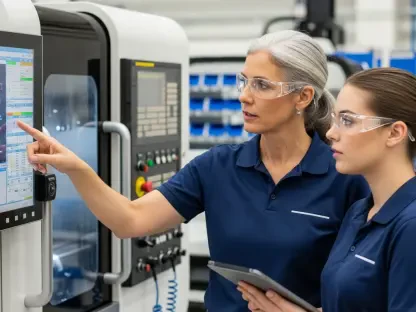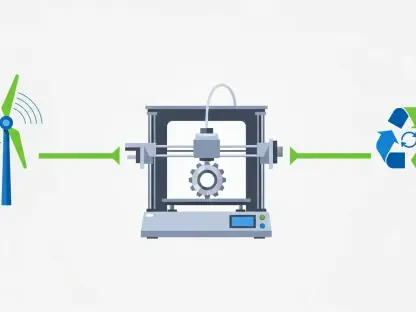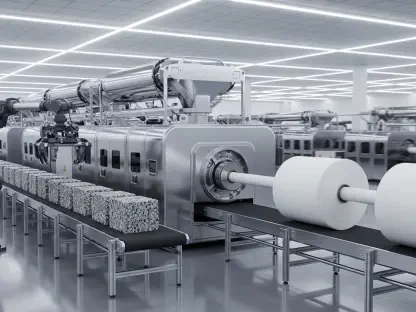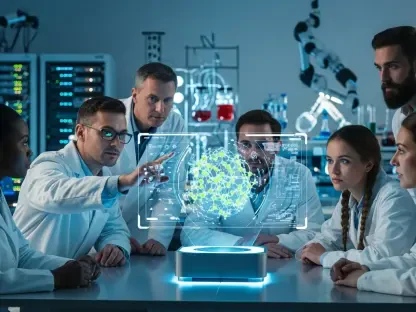Artificial intelligence (AI) and digital twin technology are at the forefront of a new industrial revolution. The integration of these advanced technologies promises smarter, more efficient factories. Notably, companies like Accenture and Schaeffler AG are leading the charge by leveraging AI and digital twins on platforms like NVIDIA Omniverse to optimize everything from factory layouts to human-robot interactions.
The Rise of Smart Factories
Leveraging Digital Twins for Efficiency
Digital twins enable the creation of virtual models of physical spaces, replicating the layout and workflows of manufacturing facilities. This virtual representation allows factory managers to simulate and optimize production lines, foresee potential issues, and improve material flow. By digitizing physical spaces, manufacturers can experiment with various setups before implementing them in the real world, saving both time and resources.
The power of digital twins extends beyond mere replication; these virtual models allow for detailed analysis and planning. Factory layouts can be optimized to ensure efficient material flows and minimize bottlenecks. This is particularly important as factories become increasingly complex, with a mix of automated systems and manual labor. Digital twins also offer factory managers the ability to conduct virtual commissioning, which is essentially testing and validating production processes in a simulated environment before they are put into real-world practice. This reduces the risk of errors and disruptions, leading to smoother operations and quicker ramp-up times.
Moreover, digital twins provide a framework for continuous improvement. They can be updated in real-time to reflect changes in the physical world, allowing factory managers to adapt to new conditions and requirements swiftly. This adaptability is crucial in industries where demand can shift rapidly, necessitating quick reconfiguration of production lines and workflows. Furthermore, by facilitating better data collection and analysis, digital twins enable predictive maintenance strategies that can prevent equipment failures and downtime, thereby boosting overall productivity and reducing maintenance costs.
Enhancing Human-Robot Collaboration
The synergy between human workers and robots is crucial for maximizing productivity. As AI advances, robots are becoming more adept at collaborating with humans, handling complex tasks previously difficult to automate. Technologies on platforms like NVIDIA Omniverse facilitate the training of robots through simulated environments, ensuring seamless human-robot interaction in actual factory settings.
Human-robot collaboration is vital in modern manufacturing environments, where the flexibility and adaptability of human workers complement the precision and efficiency of robots. AI-driven technologies allow robots to understand and react to human actions, making interactions more fluid and intuitive. This is achieved through extensive simulation, where robots learn from virtual models that mimic real-world scenarios. By the time these robots are deployed in actual factories, they are already versed in interacting with human colleagues, reducing the learning curve and enhancing overall productivity.
Furthermore, the integration of AI and digital twins allows for the continuous monitoring and assessment of human-robot interactions. Data captured from real-world engagements can be fed back into the digital twin, refining the simulations and making future interactions even more efficient. This feedback loop ensures that both human and robotic workers are constantly improving and adapting to new challenges. The benefits are manifold, including higher accuracy in task execution, reduced risk of human error, and more ergonomic workflows that prioritize the safety and comfort of human workers.
Real-World Applications
Autonomous Mobile Robots and Cobots
The deployment of autonomous mobile robots (AMRs) and collaborative robots (cobots) is revolutionizing industrial automation. Companies like Schaeffler are using these technologies to enhance operational efficiency. The EMMA mobile manipulator cobot is just one example of how mobile and stationary robots are being integrated into factories to streamline workflows and reduce manual labor.
Autonomous mobile robots (AMRs) are particularly beneficial in dynamic environments where tasks and routes change frequently. These robots are designed to navigate complex factory settings autonomously, avoiding obstacles and dynamically adjusting to new tasks. The intelligence embedded in AMRs allows them to perform a variety of functions, from transporting materials to assisting in assembly tasks. This versatility is crucial in modern manufacturing operations, where adaptability and quick response times are paramount.
Collaborative robots, or cobots, further exemplify the integration of robotics in factories. Unlike traditional industrial robots that operate in isolation or within specific cages for safety, cobots are designed to work alongside human workers. They are equipped with advanced sensors and AI-driven algorithms that allow them to detect and respond to human presence and actions safely. The EMMA mobile manipulator is a prime example, showing how cobots can assume tasks that are too repetitive or strenuous for humans, thereby improving efficiency and occupational safety.
Human-Centric and Fully Automated Workflows
From human-centric workflows to fully automated production lines, the scope of industrial automation is expanding. At exhibitions like Hannover Messe, various scenarios are showcased to demonstrate the versatility of AI and robotics in manufacturing. By leveraging advanced simulations, these demonstrations provide valuable insights into the future of industrial environments.
Human-centric workflows focus on integrating automation in ways that augment the capabilities of human workers rather than replacing them outright. This approach recognizes the invaluable role of human intuition and decision-making in complex manufacturing processes. Robots can handle repetitive tasks with high precision, while human workers supervise, troubleshoot, and optimize the overall workflow. This synergy ensures that factories can achieve high levels of efficiency without sacrificing flexibility and innovation.
Fully automated workflows represent the other end of the automation spectrum, where robots and AI systems take on nearly all tasks within a production line. These environments are exemplified by sophisticated simulations that showcase the immense potential of AI-driven automation. At Hannover Messe, demonstrations of fully automated workflows reveal how factories can operate with minimal human intervention, achieving unprecedented levels of output and quality control. These scenarios highlight efficiency and adaptability, crucial for industries where high-volume and consistent quality are essential.
Digital Twins and AI Integration
Planning and Optimization
Digital twin technology on platforms like NVIDIA Omniverse allows for sophisticated planning and optimization of factory layouts. These virtual models help in determining the best automation levels for different sections of a facility, ranging from manual labor to fully automated processes. The ability to virtually commission production lines before physical implementation is a game-changer for factory managers.
Planning and optimization are at the heart of successful manufacturing operations. Digital twins offer a comprehensive view of factory layouts, allowing managers to analyze different setups and their potential impacts on efficiency and productivity. This foresight is invaluable in identifying and rectifying potential issues before they materialize, saving time, money, and resources. The flexibility of digital twins also allows factories to model different levels of automation, enabling a tailored approach to manufacturing that optimizes costs and meets specific operational needs.
The virtual commissioning capabilities of digital twins mean that production lines can be tested in a simulated environment before being implemented physically. This ensures that systems work as intended, reducing the likelihood of unexpected disruptions or downtime during initial setup. The ability to model various scenarios also helps in planning for future expansions or modifications, providing a robust blueprint for scalable and adaptable industrial facilities. This strategic advantage helps factories stay competitive by quickly adapting to market demands and technological advancements.
Improving Robotics Performance
By using digital twins, companies can conduct detailed performance evaluations of robot fleets. This helps in optimizing the tasks assigned to robots, such as moving totes or assembling kits. The integration of data from NVIDIA Metropolis further enhances simulations by capturing real-world human and robot movements, enabling continuous improvement in robotic performance.
Evaluating the performance of robotic systems is crucial for optimizing industrial automation. Digital twins provide an effective platform for conducting these assessments by simulating various tasks and workflows. Robot fleets can be calibrated to execute tasks with maximum efficiency, whether it involves moving materials within a factory or assembling components with high precision. These optimization techniques enhance productivity and reduce operational costs by ensuring that robotic systems are utilized to their full potential.
The integration of real-world data through NVIDIA Metropolis adds an additional layer of sophistication to these evaluations. This technology captures detailed information about the movements and interactions of humans and robots within factory settings, translating this data into digital simulations. With this enriched dataset, companies can refine their digital twins continuously, making their robotic systems smarter and more responsive to changing conditions. This iterative process of improvement ensures that factory operations remain at peak efficiency year after year.
The Future of Industrial Environments
AI-Powered Real-Time Insights
AI-driven solutions, like those implemented at Schaeffler’s Schweinfurt facility, are transforming factory operations. These solutions provide real-time production insights and problem-solving capabilities through natural language queries, making factory data more accessible and actionable. This shift towards intuitive data systems marks a significant step in the evolution of industrial automation.
Real-time insights powered by AI are revolutionizing how factories operate by offering an unprecedented level of visibility and control over production processes. At Schaeffler’s Schweinfurt facility, advanced AI solutions integrated with Microsoft Fabric enable factory managers to query production data naturally and fetch actionable insights instantaneously. This accessibility simplifies complex data analysis tasks, allowing managers and workers to make informed decisions rapidly and enhance overall productivity. The transition to more intuitive data systems represents a significant evolution in industrial automation, making advanced analytics accessible to all stakeholders within the manufacturing process.
Such AI-driven insights foster proactive problem-solving, where potential issues can be identified and addressed before becoming significant disruptions. This preventative approach minimizes downtime and maintains consistent output levels. Additionally, integrating these solutions into existing workflows does not require extensive retraining, allowing factories to adapt smoothly to these new technologies. This streamlined integration helps maintain momentum in production while unlocking new levels of efficiency.
Collaborative Efforts for Global Impact
Artificial intelligence (AI) and digital twin technology are pioneering a new era in the industrial sector, promising smarter, highly efficient manufacturing processes. These advanced technologies, when integrated, have the potential to revolutionize factory operations. AI, with its ability to analyze vast amounts of data, and digital twin technology, which creates virtual replicas of physical systems, work in tandem to optimize various aspects of production. Leading companies such as Accenture and Schaeffler AG are at the forefront of this transformation. By utilizing platforms like NVIDIA Omniverse, they are enhancing factory layouts and improving human-robot interactions, thereby fostering a more streamlined and productive environment. This dynamic synergy is set to redefine the future of manufacturing, making factories not only more intelligent but also more adaptive to the ever-changing demands of the market. The collaboration between these technologies marks a significant milestone in embracing innovation and operational excellence within the industry.









